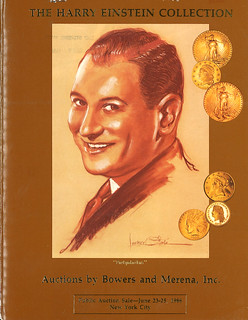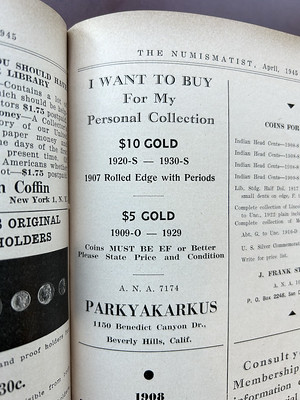
American Numismatic Society Librarian David Hill published a Pocket Change article about collector, actor and comedian Harry Parkyakarkus Einstein. Here's an excerpt; see the complete article online.
-Editor
 Recently I was leafing through an old Numismatist from the 1940s, looking for something or other, when a name leapt off the page at me:
Recently I was leafing through an old Numismatist from the 1940s, looking for something or other, when a name leapt off the page at me: Parkyakarkus. It appeared in an advertisement of numismatic wants placed by American Numismatic Association member 7174, who was looking for some rare $5 and $10 gold pieces. I knew this name. It was the moniker used by old-time comedian and character actor Harry Einstein (1904–1958), father of actor and filmmaker Albert Brooks—known for movies like Taxi Driver, Broadcast News, and Drive—and Bob Einstein—remembered for his Super Dave Osbourne character and for playing Marty Funkhouser on the show Curb Your Enthusiasm. Could this possibly be the same guy? Well, considering the likelihood of there being two Parkyakarkuses, and given the Beverly Hills address in the advertisement, the answer, inevitably, was yes.
This will come as no surprise to anyone paying attention to the world of US coin collecting in 1986. That year Bowers and Merena auctioned off the Harry Einstein collection, an event covered widely in the numismatic press and also in the New York Times (May 4, 1986)—though in that paper top billing went to an 1804 dollar (the Garrett specimen), which was in the same sale but was unrelated to Einstein.
Harry Einstein started out in radio, basing his loveable Parkyakarkus character on the Greek immigrants he encountered in his father's antique store in Boston. He was a regular on Eddie Cantor's show in the 1930s and later appeared in some movies. In the 1940s he got his own radio show on NBC, Meet Me at Parky's, which only increased his fame. According to the Numismatist (Sept. 1948, p. 618), when the kids in the Los Angeles Junior Coin Club found out Parkyakarkus had sponsored their group, enthusiasm rose to new heights.
 Einstein was a serious coin collector. Dave Bowers noted in the promotional materials for the sale that his collection had
Einstein was a serious coin collector. Dave Bowers noted in the promotional materials for the sale that his collection had those two essential ingredients that are so highly desired in numismatics: quality and rarity. He promised that the catalog would contain some of the greatest American rarities to cross the auction block in our time. The collection included nearly complete sets of gold $1 and $3 dollar pieces, a gem proof 1879 $4 Stella, multiple high relief double eagles, and various other prized gold pieces, as well as large and small cents, shield and liberty nickels, and silver and gold commemoratives. It also included the rarities he had been seeking back in 1945: the 1920-S, 1930-S, and 1907 rolled edge with periods eagles, and the 1909-O and 1929 half eagles.
Einstein, an ANS member from 1945 to 1949, built his collection with the help of his good friend, Professional Numismatics Guild founder Abe Kosoff. Kossoff remembered Einstein as being well-read and a keen student of current affairs and a savvy collector. In his Coin World column (Jan. 13, 1982, p. 40), Kosoff reminisced about the time a dealer confronted Einstein, asking why he didn't bid in his sale. I wasn't sure it was an auction sale, Einstein told the seller, because I saw the same coins in one catalog of yours after another. Either they were not rare or they were not sold, or both, he said. So I didn't care to bid.
Parkyakarkus is the kind of name that really sticks in your head. Another unforgettable thing about Einstein is the manner of his death. In 1958 he was performing alongside other show biz giants like Danny Thomas, George Burns, and Dean Martin at a Friar's Club event honoring television legends Lucille Ball and Desi Arnaz. Laughter filled the hall as one comic after another took turns at the microphone. Suddenly, Einstein, who had a history of heart trouble, collapsed, slumping against a horrified Milton Berle, who began screaming for a doctor, his cries only eliciting more guffaws from the audience, who thought the whole thing was a joke. Eventually, they got Einstein backstage, where doctors in attendance scrambled to restart his heart, improvising with whatever was at hand, cutting open his chest with a pocketknife and employing live electrical wires. But it was all in vain. Einstein had died at 54. His collection then went into a bank vault, where it sat for 40 years before reappearing in the Bowers and Merena sale of 1986.
To read the complete article, see:
Parkyakarkus
(https://numismatics.org/pocketchange/parkyakarkus/)
Wayne Homren, Editor
The Numismatic Bibliomania Society is a non-profit organization
promoting numismatic literature. See our web site at coinbooks.org.
To submit items for publication in The E-Sylum, write to the Editor
at this address: whomren@gmail.com
To subscribe go to: https://my.binhost.com/lists/listinfo/esylum
Copyright © 1998 - 2024 The Numismatic Bibliomania Society (NBS)
All Rights Reserved.
NBS Home Page
Contact the NBS webmaster
|
